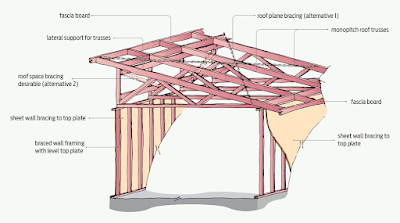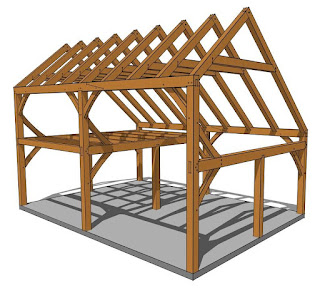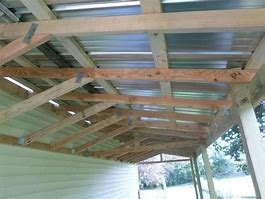Welcome to our woodworking guide on lean to shed plans with materials list. As a professional woodworker, we understand the importance of having comprehensive plans and accurate material lists to ensure a successful shed building project. In this article, we will provide you with authentic and friendly advice on how to create a lean to shed with the right plans and materials. Whether you are a DIY enthusiast or a seasoned woodworker, our guide will help you build a functional and stylish lean to shed that meets your specific needs. So let's get started!
What is a Lean to Shed?
A lean to shed, also known as a shed roof or a mono-pitched roof shed, is a simple and practical type of shed that is attached to an existing structure, such as a house or a larger shed. It is characterized by its sloping roof that slants in one direction, allowing rainwater and snow to easily drain off. Lean to sheds are ideal for providing extra storage space, protecting outdoor equipment or vehicles, and can also serve as a workshop or a gardening shed.
Why Choose Lean to Shed Plans?
Having detailed and accurate plans is essential for any woodworking project, including building a lean to shed. Here are some reasons why choosing lean to shed plans with materials list is crucial:
1. Easy and Efficient Construction
Lean to shed plans provide you with step-by-step instructions that make the construction process easier and more efficient. They typically include detailed diagrams, measurements, and illustrations that guide you through each stage of the building process. With a well-designed plan, you can save time and effort by following clear instructions and avoid costly mistakes that may occur due to guesswork or lack of guidance.
2. Accurate Material Estimation
A comprehensive materials list is a key component of lean to shed plans. It helps you accurately estimate the quantity and type of materials required for your shed project. By knowing exactly what materials you need beforehand, you can purchase them in the right quantities, avoid overbuying or underbuying, and stay within your budget. This can save you time, money, and the hassle of making multiple trips to the store during the construction process.
3. Customization and Flexibility
Lean to shed plans with materials list provide you with the flexibility to customize your shed to meet your specific needs and preferences. They often include options for different shed sizes, roof pitches, door and window placements, and interior layouts. You can choose the plan that best fits your available space, style, and requirements. This allows you to create a lean to shed that is tailored to your unique needs, whether it's for storage, workshop, or any other purpose.
4. Compliance with Building Codes
Building codes and regulations vary by location, and it's important to ensure that your lean to shed is constructed in compliance with local building codes. Lean to shed plans typically provide information on building codes and requirements, such as minimum setbacks, maximum height, and structural specifications. By following the plans, you can ensure that your shed is safe, structurally sound, and meets the legal requirements in your area.
How to Choose Lean to Shed Plans
When choosing lean to shed plans with materials list, there are several factors to consider to ensure that you get the right plan for your project. Here are some factors to keep in mind:
1. Size and Design
Consider the size and design of the lean to shed plans that best suit your needs and available space. Measure the area where you plan to build the shed and choose a plan that fits within those dimensions. Consider the height, width, and depth of the shed, as well as the roof pitch, door and window placements, and interior layout. Make sure the plan aligns with your preferences and requirements, and complements the overall aesthetics of your property.
2. Skill Level and Experience
Consider your skill level and experience in woodworking when choosing lean to shed plans. Some plans are designed for beginners, with detailed instructions and simplified construction techniques, while others are more advanced and require advanced woodworking skills. Choose a plan that matches your skill level and experience to ensure that you can successfully complete the project without any frustration or difficulties.
3. Materials List and Budget
Check the materials list provided in the lean to shed plans to ensure that it includes all the necessary materials for the construction process. A comprehensive materials list should include the type, quantity, and dimensions of all the lumber, hardware, roofing materials, and other components required. Compare the materials list with your budget to ensure that you can afford the materials and stay within your budget. If needed, you can also look for plans that provide alternative material options to fit your budget constraints.
4. Reviews and Recommendations
Look for reviews and recommendations from other woodworkers who have used the lean to shed plans you are considering. Read testimonials, reviews, and feedback from previous users to get an idea of the plan's reliability, accuracy, and ease of use. Look for any common issues or challenges faced by previous users and consider if you are comfortable with those before choosing a plan. You can also seek recommendations from fellow woodworkers, friends, or family who have successfully built lean to sheds using plans.
5. Customer Support and Updates
Check if the lean to shed plans come with customer support or updates. Some plans offer customer support, either through email or phone, to assist with any questions or issues during the construction process. Also, check if the plans come with updates or revisions, as building codes and regulations may change over time. Having access to customer support and updates can be valuable in ensuring a smooth and successful shed building project.
Building a Lean to Shed with Materials List
Once you have chosen the right lean to shed plan with materials list, it's time to start the construction process. Here are some general steps to follow:
1. Gather Materials and Tools
Review the materials list provided in the plan and gather all the necessary materials and tools. Double-check the materials list to ensure that you have everything you need, including lumber, hardware, roofing materials, and other components. Make sure you have the right tools for the job, such as a saw, drill, hammer, level, measuring tape, and others.
2. Prepare the Site
Prepare the site where you plan to build the lean to shed. Clear the area of any debris, rocks, or vegetation. Level the ground and mark the perimeter of the shed according to the dimensions provided in the plan. Make sure the site is well-drained and provides a stable foundation for the shed.
3. Follow the Plan
Follow the plan's instructions carefully, starting with the foundation or base of the shed. Build the walls, roof structure, and other components according to the plan's specifications. Use the provided measurements and cut the lumber accurately to ensure a precise fit. Follow the recommended construction techniques, such as using wood screws, nails, and appropriate joinery methods, to ensure a sturdy and durable structure.
4. Install Doors and Windows
Once the basic structure of the lean to shed is complete, install doors and windows according to the plan's instructions. Make sure they are properly aligned, level, and securely fastened. Install any additional hardware, such as handles, locks, and hinges, as needed.
5. Install Roofing Materials
Install the roofing materials according to the plan's specifications. This may include roofing shingles, metal sheets, or other types of roofing materials. Follow the recommended installation techniques to ensure a watertight and weather-resistant roof.
6. Finish the Interior
Complete the interior of the lean to shed according to your preference and the plan's instructions. This may include installing shelves, hooks, or other storage solutions, as well as painting or staining the interior walls and ceiling.
7. Apply Finishing Touches
Once the construction is complete, apply any finishing touches, such as paint or stain, to the exterior of the lean to shed. This will not only enhance its appearance but also protect it from the elements and extend its lifespan.
Materials List for Lean to Shed Construction
A comprehensive materials list is essential for a successful lean to shed construction project. Here is a sample materials list that may be included in a typical lean to shed plan:
- Lumber: 2x4, 2x6, 4x4, and other sizes as specified in the plan
- Plywood or OSB (Oriented Strand Board) for walls, roof, and floor
- Nails, screws, and other hardware
- Roofing materials such as shingles, metal sheets, or other options
- Doors and windows, including hinges, handles, locks, and other hardware
- Concrete or gravel for foundation
- Paint, stain, or other finishing materials
- Insulation, if desired
Note: The actual materials list may vary depending on the specific lean to shed plan and design you choose. It's important to carefully review the materials list provided in the plan and make adjustments as needed based on your preferences, budget, and local building codes and regulations.
Conclusion
Building a lean to shed can be a rewarding and practical addition to your property. With the right lean to shed plan and materials list, you can confidently embark on this woodworking project and create a functional and attractive outdoor storage space. Remember to consider the size and design, your skill level and experience, the materials list and budget, reviews and recommendations, and customer support and updates when choosing a lean to shed plan. Follow the plan's instructions carefully, gather all the necessary materials and tools, and take your time to ensure accurate measurements and precise cuts. With careful planning and attention to detail, you can successfully build a lean to shed that meets your needs and enhances the aesthetics of your property for years to come.
































